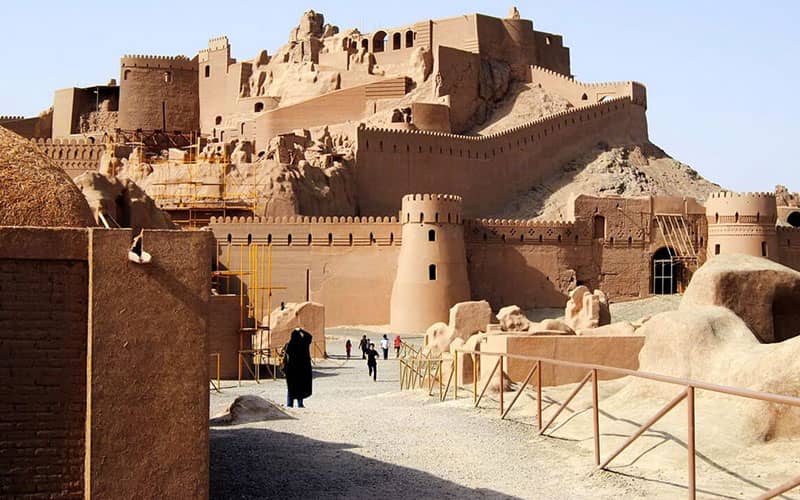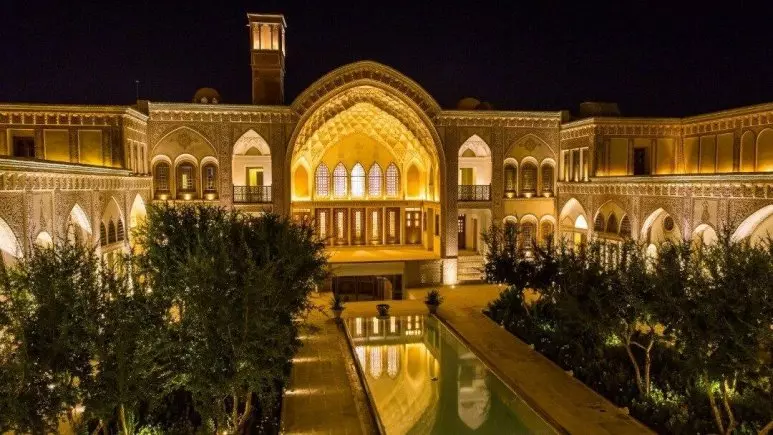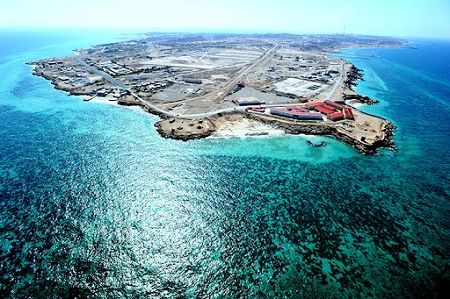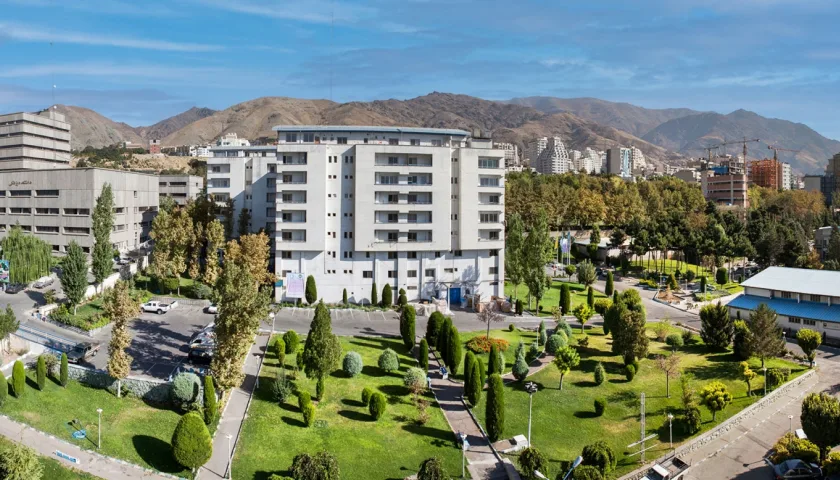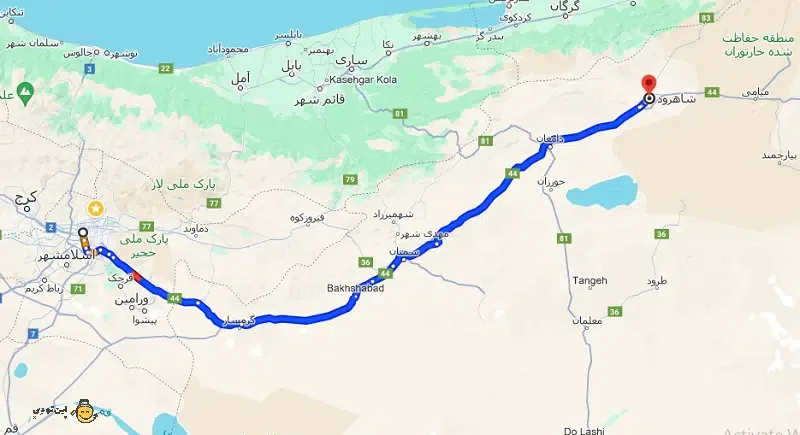Kerman Citadel Bam: A Majestic Fortress in Iran ?
Bam Citadel, recognized as the largest adobe structure in the world, is situated in the historic city of Bam in southeast Iran. This citadel, listed as one of Iran’s cultural heritage sites by UNESCO, holds a significant position along the Silk Road. Established during the Sasanian period, it is located on top of an artificial hill in the northwest quarter of the old city of Bam. This region was a crucial crossroads connecting the Silk Road and routes leading to the Middle East, the Persian Gulf, and Egypt. The citadel flourished from the 7th to the 11th century, becoming a thriving commercial center facilitating trade in silk and cotton.
The Bam Citadel complex spans an area of 315 meters along the east-west axis and 270 meters along the north-south axis. Unfortunately, around 80% of the citadel was destroyed due to an earthquake in 2003 that shook the city. However, the good news is that restoration efforts are underway, with over half of it already reconstructed.
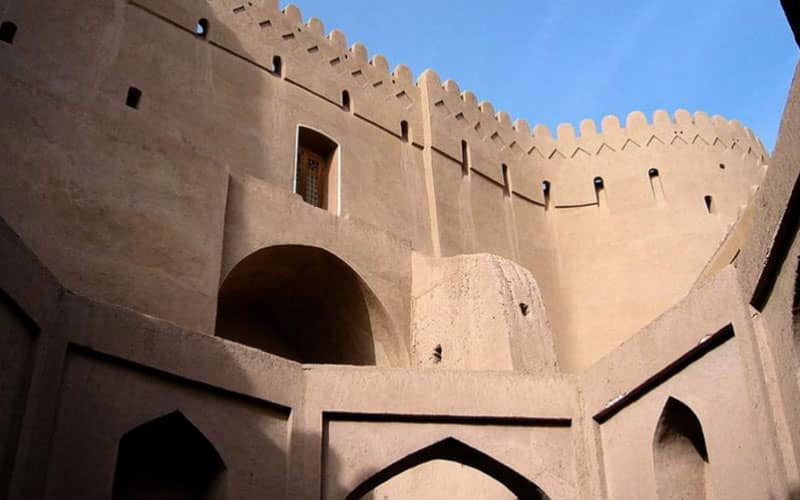
where is bam ?
Bam Citadel, positioned as one of the most famous attractions in Kerman Province, is located in the southeast, on the edge of the Lut Desert and near the city of Bam. This unique adobe structure, registered on UNESCO’s World Heritage List and recognized as a national treasure in Iran, boasts captivating architecture and serves as a remarkable example of defensive structures in Iran. Throughout history, it has acted as a formidable barrier, protecting the eastern regions of Iran. Until the devastating earthquake of 2003, Bam Citadel held the title of the world’s largest adobe structure.
The historical edifice of Arg, situated in the Bam County, remained residential until a century ago. Unfortunately, it was transformed into ruins by the severe earthquake on December 26, 2003. Continuous efforts by authorities prevented its removal from the UNESCO list, and post-earthquake, restoration and reconstruction efforts were initiated. This once-largest adobe structure in the world managed to rise from the devastation of the earthquake, once again becoming a bustling attraction for tourists, now ranking among the most visited sites in Bam. It stands as a testament to the rich history of Iran, particularly in the expansive and historical province of Kerman.
Bam Citadel has left a profound mark on the history of Iran and currently shines as a radiant gem in the vast and historical province of Kerman. It continues to attract visitors, recapturing the glory of its tourism heyday. Join us for a closer look at Bam Citadel.
How to Reach Bam Citadel
Bam Citadel is located next to the city of Bam, northeast of it, and is surrounded by two main streets, Aghman and Lutf Ali Khan Boulevard.
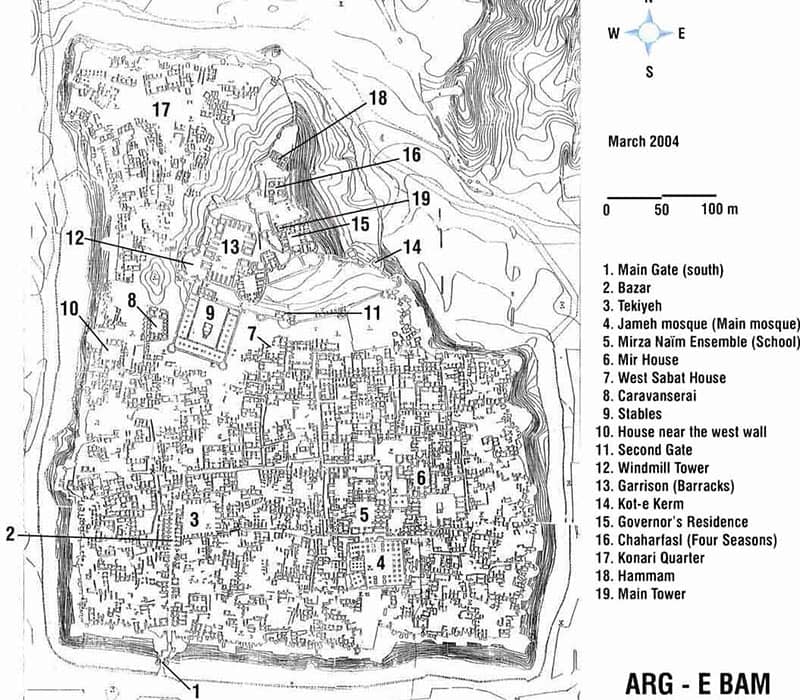
History of Bam Citadel
The earliest signs of the formation of Bam Citadel date back to the Achaemenid period. However, its development took place over several centuries, with significant expansions during the Parthian, Sasanian, and Timurid periods. Some architectural elements used in Bam Citadel, such as the combination of structural features and the natural hill on which it sits, bear a striking resemblance to Persepolis.
After Bam Citadel’s growth during the Arsacid period, it came under the control of the Sasanians, who governed the Kerman province. Following the defeat of the Sasanians by the Arabs, the city faced Arab invasions, causing extensive damage. During the time of Imam Ali (AS), the Kharijites, a rebellious group, sought refuge in Kerman and fortified themselves in Bam Citadel. Later, Ya’qub Leith Saffar, the founder of the Saffarid rule in the Sistan and Kerman region, defeated the Kharijites and gained control of Bam Citadel.
The first mention of the city of Bam in Islamic-era writings dates back to the 10th century. During this time, Bam became a developed and large market surrounded by lush fields. In that era, Bam was famous for its colorful cotton textiles and palm trees alongside its splendid bazaar.
In the subsequent centuries, local rulers in eastern Iran, including Mongol remnants, Safavids, and Qajars, utilized Bam Citadel as a strategic point in eastern Iran and a trade route from the east to west Asia that passed through Iran.

Historical Background of Bam Citadel
The historical origins of Bam Citadel are surrounded by various speculations and conjectures. Some attribute its construction to the Achaemenid era, while others connect it to the Arsacid (Parthian) period. Additionally, many of the structures within the citadel date from the Timurid era to the Qajar period. According to historical writings like “Hodoud al-Alam” and “Tarikh-e Vaziri,” the history of Bam Citadel extends back two thousand years, supported by numerous pieces of evidence, such as the presence of clay in the ruler’s house and the barracks’ commander’s house, along with the central plan layout.
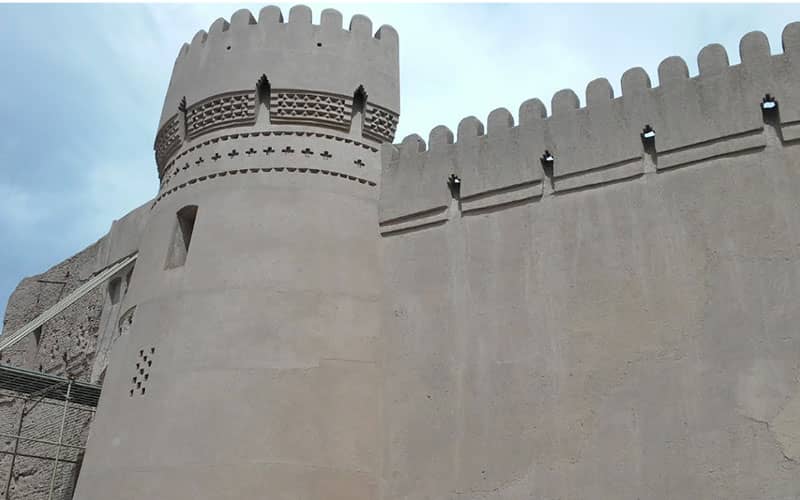
The multiple layers of construction on the walls and sections of the citadel indicate ongoing construction in different eras. Architectural features, such as the dimensions and scale of the mosque’s ivans, resemble structures from the 4th to 7th centuries, corresponding to the Samanid to Seljuk periods. The entrance dome of Bam Citadel reflects Sassanian-era design, leading to its association with this period.
Recent studies in the Parthian capital, Parthianisa, in Ecbatana, show architectural similarities with Bam Citadel. This suggests that the city’s fortress may belong to the late Parthian and early Sassanian periods.
Written documents about the military campaigns of the first Sassanian king, Ardeshir Babakan, in the Bam region during the late Arsacid period, provide some insights into the historical background. However, there are texts referring to historical structures around Bam from the Sassanian period and even earlier. The Shahnameh, for instance, recounts Ardeshir Babakan’s attack on a fortress called “Kujaran” to defeat the ruler Hafghan Boukt. Kujaran is believed to be the first foundation of Bam Citadel, and the current Bam Citadel is situated on the hill where Kujaran once stood.
After the Islamic Period
During the post-Islamic era, the presence and influence of Bam and its citadel can be observed. In this period, the Jame Mosque, Prophet’s Mosque, and a Hussainiya (prayer hall) with a two-story ivan and three brick pulpits were constructed. According to experts, the twin towers located at the entrance and the octagonal structure inside the citadel belong to the Safavid era.
Historians from the 3rd and 4th centuries of the Islamic calendar, such as Ibn Khordadbeh and Qadameh ibn Ja’far, have spoken about the city of Bam and its citadel. After the founder of the Saffarid dynasty, Ya’qub bin Laith, defeated the last ruler of the Tahirid dynasty, he exiled him to the Bam Citadel. Additionally, historical writings state that Bam Citadel served as a refuge for insurgents from the early years of Islam to the Qajar period. After being defeated by a Caliph’s commander in Shiraz in 297 AH, the ruler of Fars sought refuge in this citadel.
Nasrat al-Molk takes refuge in the Bam Citadel in 696 AH, and Amir Mobarrez al-Din, one of the successful rulers of the Al-Muzaffar dynasty, enters it after four years. Subsequently, the Bam Citadel undergoes destruction until Shaikh Ala al-Din Khorasani reconstructs it. In the era of Shah Sultan Hossein Safavi in 1105 AH and after Mahmoud Afghan’s invasion of Iran, Ashraf Afghan comes to power and dominates cities such as Narmashir, Rafsanjan, and the city of Bam.
After suffering defeat by Agha Mohammad Khan Qajar in 1209 AH, Lotf Ali Khan Zand seeks refuge in the Bam Citadel. Agha Mohammad Khan, upon entering the citadel, orders the killing and beheading of 600 captives. Three hundred of these heads are brought to Bam, and the ruler of Bam reportedly beheads the captives himself, placing all the heads on a minaret in the city.
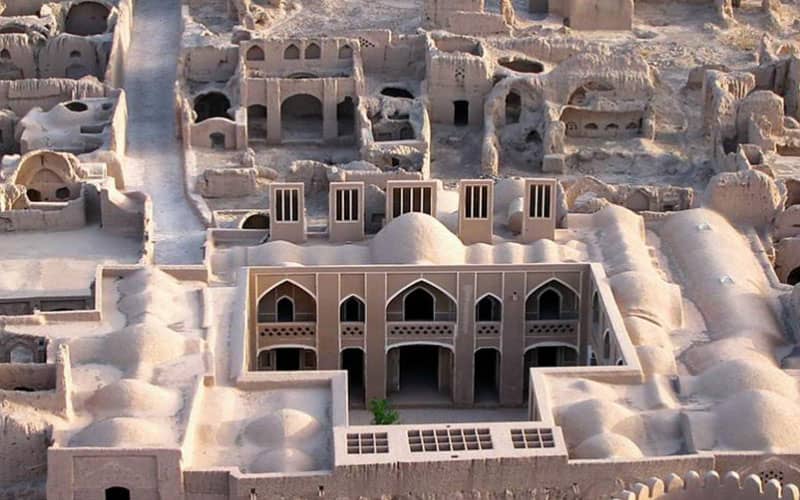
Bam Citadel and the 2003 Earthquake
The devastating earthquake in December 2003 caused significant casualties and damage to the city of Bam, placing Bam Citadel on UNESCO’s list of endangered historic sites. Gradually, the reconstruction process began with the assistance of other countries, and now Bam Citadel has been removed from the list of endangered sites.
New Discoveries from Bam Citadel
After the destruction of Bam Citadel in the 2003 earthquake, extensive efforts were made to reconstruct the adobe structure, leading to the discovery of numerous artifacts in the ruins. On the ninth anniversary of the earthquake, it was reported that unknown worship sites were found in the Bam Fault (Afraz) and the identification of ancient layers beneath Bam Citadel’s structure. Additionally, rock carvings from three different periods were found in the rubble of Bam Citadel, depicting scenes of hunting animals such as goats and leopards with bows and arrows.
However, a question may arise for travelers planning to visit Kerman: What are the most terrifying discoveries from Bam Citadel? In fact, the most horrifying discoveries include the bodies of 68 infants found within the walls of Bam Citadel. Archaeologists estimate that these children were buried in the walls of Bam Citadel approximately 200 years ago, and their skeletons were unearthed during recent excavations in the area. It’s noteworthy that all the discovered skeletons belong to children aged one to six years. Perhaps strangely, but based on Dr. Leila Papoli’s DNA tests, it was determined that all these children were boys. Some people, relying on Dr. Papoli’s reports, believe that these discovered bodies may be related to an ancient ritual of sacrificing boys.
Architecture of Bam Citadel
From the external appearance of Bam Citadel, it seems that the designers had envisioned the final shape of the entire city from the very beginning. Bam Citadel resembles a massive and robust fortress designed not only to ensure security within the city but also to prevent enemy intrusion. The presence of towers and bastions within the fortress, along with hidden passages and command headquarters on the summit, speaks to its high level of security.
Research studies indicate that the Bam Citadel complex shares structural characteristics with examples of grid city planning in the Middle East and Mesopotamia. The construction of this citadel follows the traditions of the Medes and the Parthians, situated on a high hill to hinder enemy access and increase control over the surrounding areas. Furthermore, locating the government headquarters at the highest point of the fortress allowed for supervision over lower levels, and the steep slope leading to the governing section made access more challenging.
Experts believe that the existence of residential neighborhoods and their connections, numerous historical structures, and the arrangement of buildings on the slope of the hill, culminating in the extraordinary Four-Season Mansion at the highest point of the citadel, showcase the exceptional value of its urban planning and architecture. In this adobe fortress, dating back 2500 years, raw materials such as clay, stone chaff, straw, and raw bricks were used, preserving its original structure over centuries. Indeed, the imposing appearance and security features of the Bam Citadel suggest that its design and construction were based on military and defensive considerations. The strength and grandeur of Bam Citadel led to it being named the “Castle Created by God” during the Qajar period.
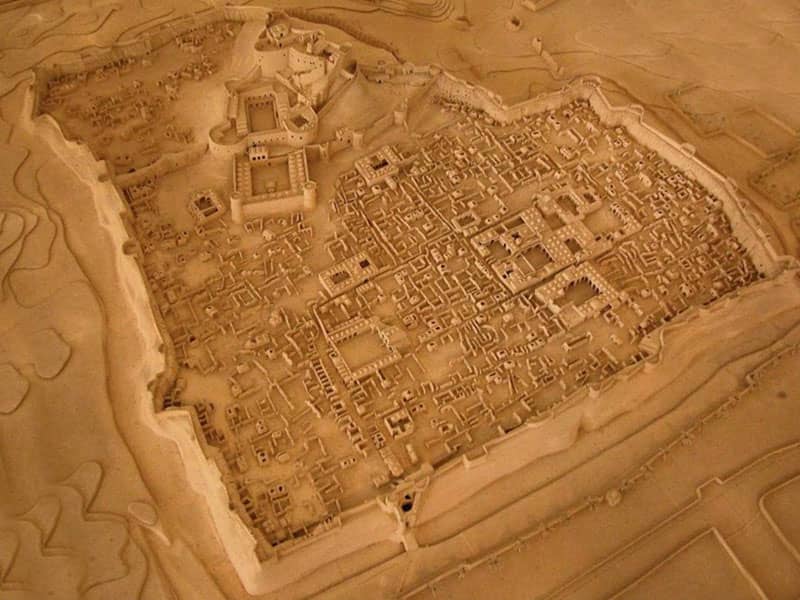
The engineering features of Bam Citadel tell the story that builders centuries ago utilized wind engineering, combining it with water engineering and architecture to create a ventilation and humidity regulation system. Considering the high temperatures and low humidity in this region, a location with the highest wind intensity was chosen for building the Citadel. Wind entered from the western part of the Citadel, passing through spaces and valleys, creating a dominant airflow. Engineers used water supply and wind-catching systems to temper the air and cool the Citadel, allowing the airflow to reduce the temperature inside.
Different Sections of Bam Citadel
The geometric shape of Bam Citadel is rectangular, measuring about 200 meters in width and approximately 300 meters in length. It consists of two main parts: the upper section and the lower section. The division into two parts is considered the most significant architectural feature of this complex, designating the main citadel and its surrounding areas for governmental purposes (upper section) and other sections for the residential areas (lower section).
The bifurcation of the structures within Bam Citadel can be considered its most important architectural feature.
The main sections of Bam Citadel include the main gate, the bazaar, the Tekyeh Square, the Mirza Naim Complex, the Jame Mosque, the Prophet’s Mosque, a bathhouse, the Four-Season Mansion, the second gate of the rampart, a school or Khanqah, a caravanserai, a windmill, a stable, a granary, the governor’s house, the main well of the citadel, the Kit Karim Gate and Prison, the location of a windmill, remnants of the old neighborhood, and the Ghulam Mahalleh or Kanaye Mahalleh.
The current structure of Bam Citadel has undergone changes and renovations throughout different periods, with evident influences of Islamic architecture. Although certain parts of it date back to pre-Islamic times, the overall architecture reflects adaptations and modifications over the centuries.
Upper and Lower Sections
The governmental section is situated in the north of Bam Citadel and consists of structures such as the military fortress, the governor’s house, a bathhouse, barracks, a well, the Four-Season Mansion, a stable, the main tower, a windmill building, and the Kit Karim Gate and Tower. The governor’s residence is placed just after the second gate, located on the mountain and in the sloping terrain. In this area, an impressive stable can be observed, featuring a well and a water reservoir within its courtyard. Beyond the stable, one reaches the governor’s residence and the barracks. A windmill from the Qajar period is visible in the southwest tower, making it the only windmill in the Bam region.
The Four-Season Mansion, situated in the governmental section, is considered one of the highest points of the citadel. A bathhouse is located behind it, and a path from behind the Four-Season Mansion leads to the Kit Karim Gate, apparently designed for the escape of the ruling authorities during crises.
The Four-Season Mansion, used for city administration and issuing decrees, consists of three stories, each distinguished by architectural elements. Based on the arches’ shapes, forms, and building materials, it can be concluded that the lower story is older. This section exhibits architectural features reminiscent of the Sassanian and Ashkanian periods, possibly indicating its construction after the defeat of the Hephthalites under the order of Ardeshir.
Until about 80 years ago, in the mid-Qajar period, life in this citadel was thriving, serving as a gendarmerie and military headquarters.
Peasant Section
Separated by a high wall from the governmental section, the peasant section encompasses various parts, including the Cold Gateway building, the main entrance to the city, the entrance path to the fortress, the bazaar, a school (Khanqah), a workshop, a sabat, Tekyeh Square, the Jame Mosque, the Prophet’s Mosque, a bathhouse, a stable, the Mirakhour building, and residential and public buildings.
The workshop (Zurkhaneh) of Bam Citadel resembles traditional stadiums, consisting of a dome, four porticos, and a pit. A covered alley, known as Sabat Jehudha, is also present in the citadel.
Stable
The stable area, with a capacity for around 200 horses, is located at the entrance to the second gate of the city. It still retains troughs and a water reservoir. This stable, considered one of the most beautiful structures in Bam, is adorned with Mongol and Timurid period stuccos.
Moat
The presence of a moat surrounding Bam Citadel served to enhance its defensive capabilities against enemies. The fact that the moat was dug along the path of a flowing river demonstrates the ingenuity of ancient Iranian architects, especially considering its strategic defense purpose.
Tower and Ramparts
A very large tower and ramparts surround Bam Citadel, featuring 29 tall watchtowers at irregular intervals along the slopes of the hills. Interesting features of the guard towers include trapezoidal-shaped openings designed for observing the city, expanding the guards’ field of vision, and restricting the passage of arrows and injuries to the guards. Additionally, 76 guard towers were incorporated at the city level.
Walls
One unique feature of Bam Citadel is its four walls. The first wall, with a height of 18 meters, protected the people from enemy attacks, and in some sections, its width exceeded 6 meters. Guard towers were integrated into some parts of this wall to serve as resting places for officials and guards, enhancing both the strength and fortification of the wall. The outer wall of the citadel was surrounded by a trench.
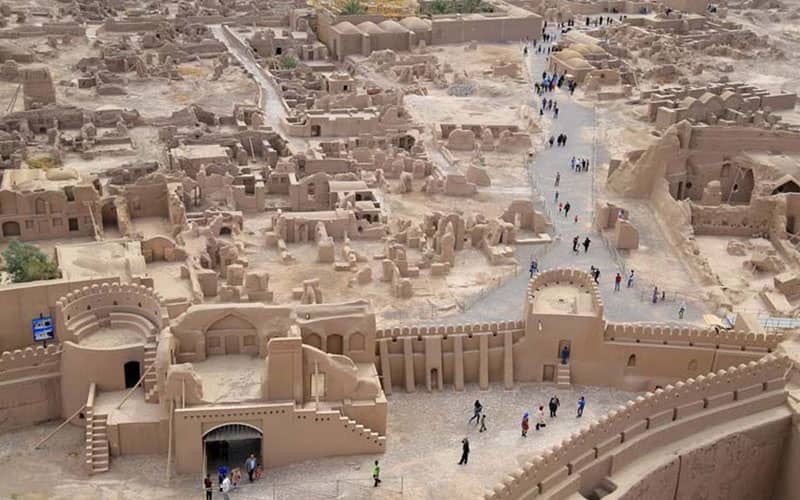
Houses
The houses in Bam Citadel are categorized into ordinary houses, semi-aristocratic houses, and aristocratic houses. Smaller houses belonged to the poor and typically had two or three rooms. Medium-sized houses, some with porticos, belonged to the middle class. Interestingly, aristocratic houses were equipped with both indoor and outdoor spaces, water wells, stables, and private baths.
Some houses in the citadel were constructed with two floors without regard to column resistance and load-bearing capacity, indicating population growth during certain historical periods. Contrasts in the size and durability of houses can also be observed.
Gateways
The city gateways were designed based on the needs of different social classes and defense requirements. The initial city wall consisted of four large gateways.
The gateway of Bam Citadel leads to a market that extends about 90 meters. The remains of its shops are still visible. In the northern part of the citadel, in the Kit Karim neighborhood, remnants of the second gateway can be seen, apparently blocked after the construction of the citadel wall.
These gateways were designed in a way that once closed, no human or animal could enter. The presence of gardens, water wells, and domestic animals within the citadel allowed people to live behind closed gates for extended periods.
Jame Mosque
The Jame Mosque is one of the most important and largest structures in Bam, holding significant importance for the city’s residents. On Mondays and Fridays, candles were lit and vows were made in this place to fulfill intentions. During the restoration of Bam Citadel, candle boxes with candles dating back to the pre-revolutionary period were discovered.
Before the Safavids, the area of the Prophet’s Mosque, the Jame Mosque, and the Husseiniyeh were used for displaying and showcasing commercial goods.
This translation provides a comprehensive overview of the different sections of Bam Citadel, including the upper and lower sections, the peasant section, and key features like the moat, towers, walls, houses, gateways, and religious structures.
Wonders of Bam Citadel
Windcatchers:
One of the peculiarities of life in Bam Citadel is how people coped with the extremely hot weather of the region. In fact, each building’s architecture incorporated windcatchers, guiding the wind into the structure and acting as a natural cooler. Interestingly, larger and more important buildings used four-sided windcatchers, while smaller buildings utilized single windcatchers to allow wind entry from various directions.
The placement of the main gate also directed strong winds out of the citadel. Another interesting aspect was the existence of small ponds in the wind’s path. Besides cooling the air, these ponds prevented dust and dirt, emphasizing the unique architectural style of Bam Citadel.
Water Supply System:
Bam Citadel has three well rings located next to the Four-Season Mansion, in the artillery square, and at the stable. Archaeological excavations in the northwest of the citadel revealed water supply facilities, where water from the dual-channel qanats branched through a distribution building. Part of it reached the Shotor Gulu building in the western trench and then entered the citadel’s central area. Finally, in the western part of the peasant section, it flowed on the ground surface. A public bathhouse in this area used this water for bathing.
Children’s Cemetery:
After the 2003 earthquake, bones were unearthed from the walls of Bam Citadel, consisting of 68 child and infant bodies. The age of these bodies dates back several years. After the Bam earthquake, more child bodies were buried in the walls, turning Bam Citadel into a standing cemetery for children. DNA analysis revealed that these children were aged between one and six years, all male. The bodies were reburied in the same location to prevent skeletal destruction after sampling and studies.
On the shrouds of the children, there are notable illustrations that do not comply with Islamic laws. It appears that people in the past lived in Bam Citadel with various rituals, and as non-Muslims were not allowed to bury their dead alongside Muslims, this might explain the burial of children in the citadel walls. However, there are other theories. For example, it is said that the age of the children’s bodies dates from the restoration of the citadel walls after the Afghans’ attack to the Qajar period. This was a time of less conflict in the region. Additionally, the fact that all the children were boys strengthens the possibility of this being based on a historical practice of boy-killing.
The burial of children in the walls of Bam Citadel took place in three ways. Smaller children were completely placed in bricks, effectively turning the brick into their coffin. Some children were positioned in the space between bricks, and in the third method, which pertains to contemporary children, the bodies were buried at the base of the wall on top of each other and were found later, as they were covered, in a stack.
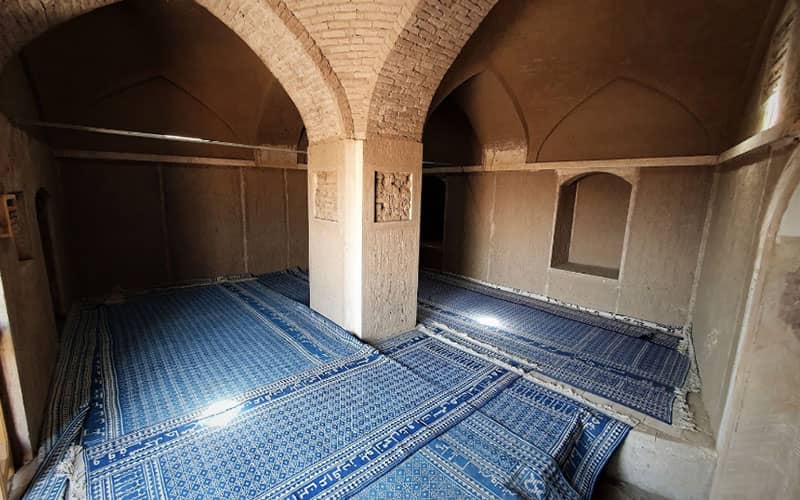
The War of Lotf-Ali Khan Zand and Agha Mohammad Khan Qajar
During Agha Mohammad Khan Qajar’s invasion, Lotf-Ali Khan Zand had no choice but to flee from Kerman to Bam. During his escape, he was accompanied by three individuals, and one of them was Jahangir Khan Sistani, the son of the ruler of Bam. Unfortunately, Jahangir Khan went missing in a sandstorm. Ultimately, Lotf-Ali Khan entered Bam Citadel alone two days later. Due to exhaustion, he fell asleep in Bam Citadel’s hall, only to wake up to the sound of horses and find himself surrounded by Agha Mohammad Khan’s forces.
The ruler of Bam, unaware of his son’s disappearance, assumed that his son had been captured by Agha Mohammad Khan, and, as a result, surrendered Lotf-Ali Khan in exchange for his son’s freedom. However, Lotf-Ali Khan did not surrender easily. According to exaggerated local tales, he fought so fiercely that the bodies piled up like logs until sunset. Eventually, Agha Mohammad Khan’s soldiers targeted his horse, bringing him down.
Bam Citadel in Shahnameh
It is interesting to note that Bam Citadel is mentioned in Ferdowsi’s Shahnameh. According to Ferdowsi, after conquering one of the local rulers, Havoat establishes a fortress on a mountain near Kujaran, which might be the first foundation of Bam Citadel. Ferdowsi describes the military expedition of Ardeshir Babakan to Havoat’s city in an epic manner. According to this legend, in the city of Kujaran, next to the Pars Sea, there was a mountain where the city’s girls went every day for spinning. One day, a girl named Havoat found an apple along the way, and inside it was a worm. She placed the worm in a casket, and prosperity and growth increased.
Due to the worm’s song, Havoat and her sons became wealthy. The city’s ruler, seeking to extort Havoat, went to her but was resisted. With the help of the people, he took control of the city, killed the ruler, seized the treasury, and subsequently built a strong fortress atop the mountain. The worm grew each day until, after five years, it became as large as an elephant. Havoat, due to the power of Havoat, extended from Kerman to the Sea of China.
Upon hearing the news of Havoat, Ardeshir Babakan sends an army to fight him, but they face defeat. Therefore, Ardeshir personally goes to battle Havoat. Havoat successfully besieges Ardeshir and his troops, killing many of his soldiers. Ardeshir sees no way other than to escape. He encounters two young men in a narrow pass, who suggest that to defeat Havoat, he should think of a strategy other than war. Ardeshir, along with seven individuals disguised as merchants, enters the fortress. Using trickery and deception, they convince the guardians to entrust the care of the worm to them for three days. The guardians accept this request.
Ardeshir pours molten lead into the worm’s mouth, pulling it down from its feet. Then, by lighting smoke on the fortress’s roof, he commands his army to attack. As a result, Havoat is hanged, and all the fortress’s treasures are plundered.
Frequently Asked Questions
Where is Bam Citadel located?
Bam Citadel is located in the city of Bam in the Kerman province.
What happened to Bam Citadel after the Bam earthquake?
The earthquake in 2003, measuring 6.6 on the Richter scale, destroyed 80% of Bam Citadel, leading UNESCO to list it as a World Heritage Site in Danger. However, with financial and technical assistance from UNESCO and some member countries, the restoration and preservation of Bam Citadel began. Eventually, in 2013, it was removed from UNESCO’s list of endangered heritage sites.
What is the historical background of Bam Citadel?
There are various speculations about the historical background of Bam Citadel, with some attributing it to the Achaemenid and Arsacid periods. Numerous structures within the citadel date back to the Timurid to Qajar periods.
What are the architectural features of Bam Citadel?
The architecture of Bam Citadel is designed for security and defense. Features such as towers and walls, strategic placement on a high hill, the establishment of the governmental center at the citadel’s highest point, the presence of residential quarters, their interconnected layout, wind engineering, the combination of wind and water engineering for natural ventilation, the water supply system, and more, all contribute to an extraordinary architectural design.

